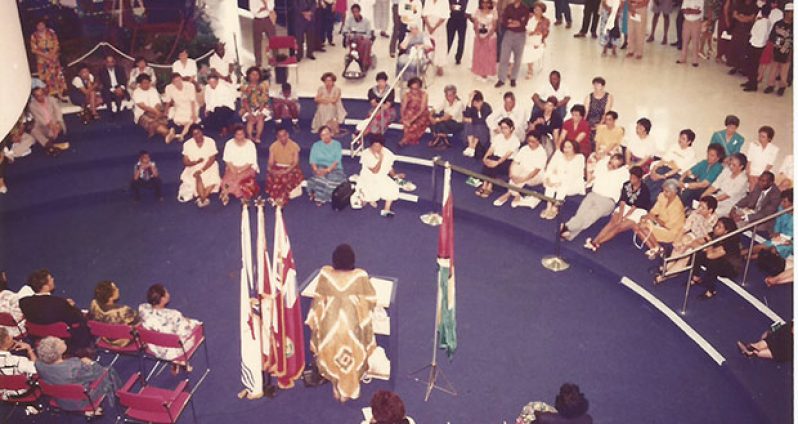While there seems to be a significant increase in the number of artist-led initiatives (at least everywhere else except here in Guyana), it is hardly a new trend. In fact, Guyana has a strong history of these types of initiatives dating back to the 1930s and 40s. So how have we managed to fall so far off the map that there has been no serious or critical engagement since? A number of contributing factors come to mind, but perhaps the most important of them all (at least in my opinion) is the incredibly flawed education system we’ve suffered through.
An education that is inclusive and free from archaic teaching models that have anchored us in a sea of mediocrity is the only thing the will force us out of this stasis we’ve found ourselves in. This is something that I’ve said time and again. If we were to examine every failed model, in any imaginable discipline, it would always lead us back to the way we are teaching students and future professionals. It really does start at the earliest level of education, which means the syllabus needs to be overhauled.
In 2016 we are training artists, performers and musicians without an arts management course of any kind that would hopefully eliminate the need for those practitioners to be chief, cook and bottle washer. In the 53 years since the University of Guyana has been established, there is no course that offers professional business practices to artists preparing for their big debut in the real world. I’ve had countless graduates look at me with furrowed brows at the mention of an “artist residency” and it’s completely baffling. In this age of technological advancement, most of them are unaware of the relevant and critical theories being discussed outside of this local bubble and how they are inextricably linked to their own practices.
Stanley Greaves, in conversation with me some time back, said, “You don’t go to the art school to learn how to be an artist.” I couldn’t agree more. You go there to learn how to survive as an artist. If you’re shelling out millions of dollars for a university degree then you deserve to be taught the practical methods of applying said degree to sustain a thriving art practice in an ever-changing market. You deserve to be taught the importance of forming collectives and how they can shoulder some of the burden you will inevitably face as a creative practitioner.
There is an enormous administrative elephant that most of our art tutors casually overlook when delivering lessons on the correct way to paint. Art students aren’t being taught what they really need to know to be taken seriously in the creative discourse happening regionally. This is why so many talented individuals have slipped through the cracks after graduating from the art school. There is no system in place that prepares them for the rigors of the professional creative field after they would’ve completed their studies. In fact, most times they have no idea what the requirements are to begin with. But they’re really talented painters so that should be enough right? Who needs to know how to write proposals, apply for grants, draft contracts, press releases or artist statements?
The absence of programs that are geared towards sustaining creative endeavours says a lot about our position (or lack thereof) in the grand scheme of things in this our beloved country. If you don’t believe this to be true then I challenge you to find a single advertisement, seeking applicants for an arts scholarship in any of our local newspapers. I’ll wait. The truth is you will see calls for every other area except the creative arts. There is no existing framework that continuously supports the work of creative practitioners in Guyana and no one has had the foresight to change that in the fifty years since we’ve stopped getting support from the British government. Or maybe these issues have been raised in the past but that pesky red tape…
Regardless, this is where I think artist-led initiatives can step in as a type of supplementary model while the decision makers figure out which way is up. Although there are at least three different types of artist-led initiatives (artist cooperatives, artist collectives and artist-run spaces), they all have the potential to make invaluable contributions to their members and society at large. In addition to providing space for artists to work, exhibit and engage in critical discussions about their individual production, these initiatives also have the potential to activate communities by breaking down barriers to create an environment that fosters creative exchange among participants.
These groups can be used to facilitate high school students preparing for the art school, graduates that have already left the art school as well as established artists interested in sharing their experiences as professional practitioners. In fact, we can think further ahead to eventually hosting regional and international artist residencies in an attempt to strengthen creative ties with our neighbours as we re-enter the conversation of serious art production within the region. So many opportunities for travel and networking with other members of creative disciplines would be created as a result.
In theory this is a wonderful idea but the reality is that the elephant hasn’t left the room. The administrative work involved in establishing one such initiative is daunting to say the least. Trying to keep the ship afloat by handling the never-ending paperwork while actively seeking funding and still trying to find time to produce art is sure to wear down even the best of us. But there is strength in numbers and if you are surrounded by a group of like-minded individuals who are willing and able to go the extra mile, then the rewards far outweigh any challenge that might present itself.




.png)









